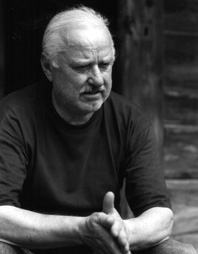Over the years, Bronius Kutavičius' ability to create an acoustic image of history has become widely acknowledged. It is therefore no coincidence that he was commissioned by the state to write a large-scale work commemorating the 750th anniversary of the coronation of Lithuania's first and only king, Mindaugas. The composer wrote Ignis et fides (Fire and Faith) for solo voices, reciters, choir and symphony orchestra, plus some folk instruments. This diptych will unite two dates of importance for Lithuania: the first mention of the name of Lithuania in historical sources, and the coronation of King Mindaugas.
|

photo: Arūnas Baltėnas
|
The task was not an easy one, for there is little historical data about the period and the actual fact. "I really did not want to make it a soviet-style glorification and lauding, which is absolutely alien to me. I spoke with historians, who told me there is only one surviving sentence referring to this event: that King Mindaugas was crowned in July 1253." Because the coronation of Mindaugas is closely related to the introduction of Christianity into Lithuania, the composer included one more event in his work - the martyrdom of Bishop Bruno (sent to convert the pagans of Prussia, a kindred tribe to the Lithuanians) - which in fact became the reason for the first known historical mention of the name of Lithuania, in 1009. The collision of Paganism and Christianity was also the major conflict and driving force in what is probably the composer's most popular work, the oratorio
Last Pagan Rites (1978). As the composer says, he is very fond of, and comfortable with such confrontations.
The work is in two movements. The composer himself wrote the libretto for the first movement, based on three historical sources (the accounts of Wibert, Pietro Damiani's "Life of St. Romuald", and the anonymous "Life and Suffering of St. Bruno"). The text of the second movement was partly created by religion researcher Gintaras Beresnevičius, who wrote the text for a more intimate scene between Mindaugas and his wife Morta. After all, changing one's faith is a very personal drama.
The composer skilfully introduces separate authentic details from the historical epochs,
kanklės (folk zither) - an ancient Lithuanian folk instrument, texts from the psalms, Sanctus and Te Deum, the few surviving words of the Prussian language, authentic
sutartinės (archaic polyphonic folk songs), a Catholic sermon from the Renaissance period, a hymn by
Hildegard von Bingen, fanfares, the ringing of Vilnius church bells, and so on. A recording of real thunder at the end of the work serves not as an illustrative effect, but as a symbol of soon-to-return Paganism, and its chief god Perkūnas (Thunder).
Kutavičius makes use of undeveloped instrumental phrases and short repeating segments to represent the pagan world; strange and interesting combinations occur, e.g., in Mindaugas' and Morta's duet. According to the composer, "this was especially difficult, for I didn't want to revert to opera singing". The Christian segment of the work unfolds in the psalms, with a melody reminiscent of Gregorian plainsongs. The composer hopes for a certain spatial effect in specific scenes - some of the performers emerge, others recede, in order to create a movement of sound on the stage.
The composer is interested in the very spirit of ritual, and he would like to draw the audience in as well. To achieve this, the meaning of the text is reduced to a minimum intelligibility. Kutavičius: "Text seems to betray certain secrets, and I feel that one can say a lot more without, than with text. The psalms are in Latin, and the Prussian text in the first movement is unrecognizable as well. The public will of course be upset, saying that they can't understand anything. But it's the tone of the text, not the meaning of the words, that is more important to me." The three languages – Latin, Prussian, Lithuanian - both reflect the historical fate of Lithuania, and represent the imprint of the major historical lines of the piece.
The new work has features of opera, oratorio and ballet - mostly ballet, for the music is predominantly instrumental. Kutavičius freely balances between various traditions, and in his own way connects many of the things that he finds necessary at the time. In many of his works, the composer managed to create a truly unique poetic theatre, which rose out of the musical language itself. Theatre permeates his oratorios; his opera-poem
Thrush, the Green Bird (directed by Jonas Vaitkus) was a landmark work in Lithuanian music, emerging out of an ethnic tradition, and embodying a new concept of unity and action. Jonas Vaitkus is in charge of staging this new work as well. The composer himself says that here he is dealing with a fair bit of risk: "There were, after all, quite a number of solo episodes and a lot of text in the opera-poem
Thrush, the Green Bird - it was, in the end, an ethnographic opera. Here I've risked constructing a large-scale stage production with no plot. Which is quite brave, I think."
© Rūta Gaidamavičiūtė
Lithuanian Music Link No. 6

